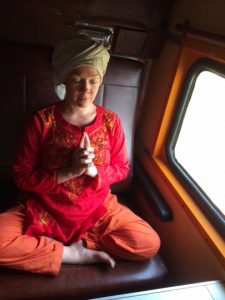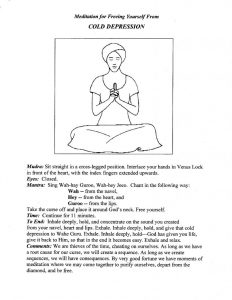 If you don’t have the privilege of living off-grid or in an ashram in Tiruvannamalai, you’re likely to have – or to have encountered in someone close to you – cold depression.
If you don’t have the privilege of living off-grid or in an ashram in Tiruvannamalai, you’re likely to have – or to have encountered in someone close to you – cold depression.
Cold depression is our response to the increasing pressure being put on us by social media, a speedy pace of life, an overload of information at the click of a mouse that often contradicts and conflicts, technological advances that allow us to override the limitations of the physical plane via Skype, FaceTime etc. In other words, life right now as we know it.
It manifests many ways, but its overarching quality is disconnection from ourselves and others, preventing us from fully engaging with our life and the people in it. And ironically, we turn to the very cause of our cold depression to soothe that wound of disconnection. It’s plugging earphones in on the train, or playing Jelly Splash on our phone, or binge-watching Breaking Bad. Anything to 1. Distract us from the feeling of numbness/ ennui/ emptiness and 2. Give us an excuse not to engage with those around us.
The result? A deepening of that ‘cold’ dislocation and isolation despite being surrounded by multitudes of people. We become disinterested or even fearful of connection. It’s like being in a jar on a hypermarket shelf with millions of other jars – all of them containing the same joys, fears, hopes – but with no capacity to share in them. It’s a feeling of numbness and isolation.

Although I didn’t know it at the time, I used to suffer with cold depression. Even though I had a regular hatha yoga and meditation practice, I felt totally disconnected from myself and from everyone around me. Cold depression is so insidious, it’s hard to recognise it when you’re in it – perhaps because so many of us suffer with it and it’s become the norm. But I knew there was something missing. I was desperate for sustenance but I didn’t know what that sustenance was. On good days, I was seeking it in my Astanga practice, YouTube satsangs etc. On bad days, it would be chocolate. But I still felt so disconnected.
The cold depression took years to lift, but it started to after I began to practise kundalini yoga. I now recognise it for its absence. While I still sometimes struggle with big city living (hello London, you bubbling cauldron of cold depression, you!) and an overwhelmingly speedy lifestyle, I now go out of my way to connect with others – to smile when I catch someone’s eye instead of quickly glancing away, or to tell someone if I love their beautiful fuchsia dress or that I enjoyed the book they’re reading (there was someone with Eckhart Tolle’s Power Of Now on the Tube a few days ago – wahooo!). It’s not just to acknowledge that, hey, we’re both human beings here! I also do it to crack through the veneer of their own cold depression. Catching someone off guard is a good tactic to do that.
 Here’s a meditation for cold depression that I really enjoy because it brings me BAM into my heart. And this, our heart, is where we can find a resolution to this insidious condition. When we live from our heart, when we keep our awareness and centre of focus there rather than in our noisy, chattering, often unhelpful mind, we can encounter and rediscover our innate sensitivity, our true feelings and reactions to the world around us rather than pressing them away. And when we engage with whatever these feelings are, whether sweet or uncomfortable, we can slowly thaw the cold depression that’s been keeping us ‘out in the cold’ for so many years. We can rediscover our divinity, and we can learn to see that same divinity in those around us. I practised this meditation while I was in travelling in India and it certainly helped me stay steady, focused and connected to my heart.
Here’s a meditation for cold depression that I really enjoy because it brings me BAM into my heart. And this, our heart, is where we can find a resolution to this insidious condition. When we live from our heart, when we keep our awareness and centre of focus there rather than in our noisy, chattering, often unhelpful mind, we can encounter and rediscover our innate sensitivity, our true feelings and reactions to the world around us rather than pressing them away. And when we engage with whatever these feelings are, whether sweet or uncomfortable, we can slowly thaw the cold depression that’s been keeping us ‘out in the cold’ for so many years. We can rediscover our divinity, and we can learn to see that same divinity in those around us. I practised this meditation while I was in travelling in India and it certainly helped me stay steady, focused and connected to my heart.
That, along with a steady kundalini yoga practice, and we’ll thaw out in no time.
Sat nam x
